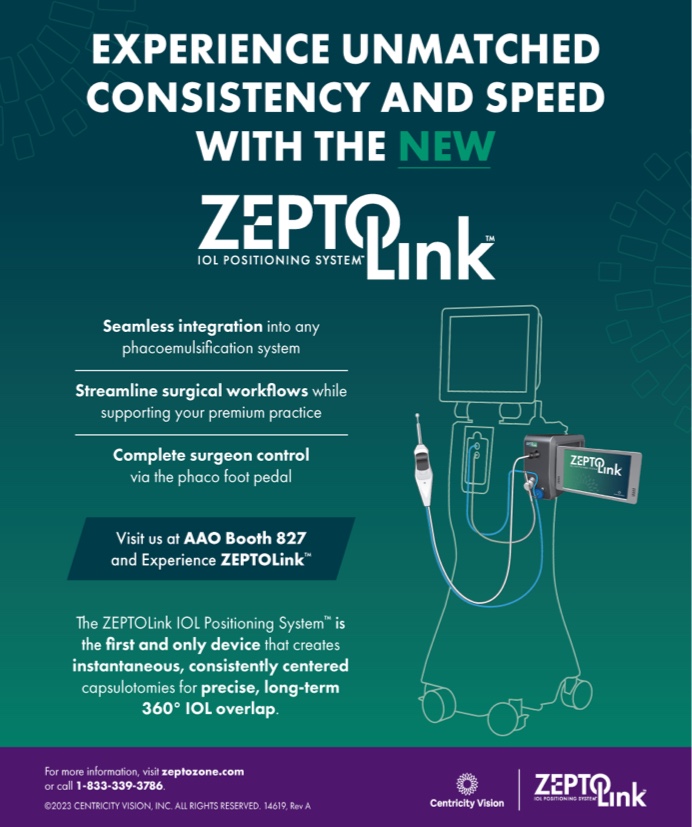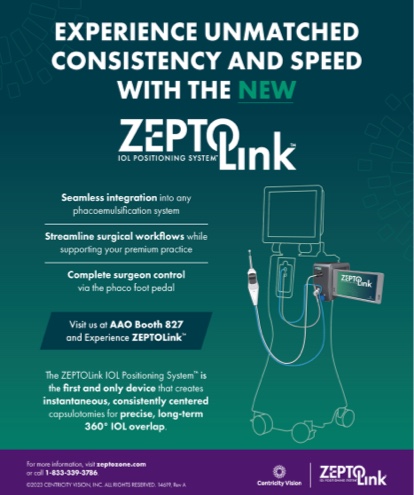Refractive Surgery | Aug 2005
Iris Registration
An incremental improvement in wavefront-driven laser vision correction has occurred.
Jeffery J. Machat, MD
One key to obtaining optimal visual quality after wavefront-driven laser vision correction is to be able to match well the intended ablative shape with the one actually placed on the cornea. Several manual means are currently utilized to achieve this type of registration, including head alignment and the matching of scleral ink markings.
The latest technological development for the registration of the intended and ablated wavefront shapes is automated iris registration, which was recently approved by the FDA for use with the Visx Customvue wavefront-guided system (Visx, Incorporated, Santa Clara, CA). Iris registration relies on matching reference points in the natural iris pattern to compensate for cyclotorsion and a pupillary centroid shift between the time of wavefront capture and the ablation.
I have been utilizing iris registration for several months and will present a few case studies that exemplify how important this technology has been to improving outcomes in my practice.
Personal experience
Case 1
A 55-year-old male with high cylinder preoperatively (+0.25 -4.50 X 164 OS) experienced cyclotorsion of 5.8º during surgery. With iris registration, he had an excellent outcome and maintained his preoperative BCVA of 20/20. Without iris registration, the patient would have had induced sphere and cylinder and a potentially reduced quality of vision, as a theoretical convolved point spread function and Snellen E demonstrate (Figure 1).
Case 2
A female patient had both high cylinder (-4.50
-4.75 X 3) and higher-order RMS (0.46µm) preoperatively. With iris registration, she gained two lines of BCVA postoperatively. Without iris registration, her 4.9º of cyclotorsion during surgery would have resulted in, again, induced sphere and cylinder and a poor quality of vision. The accuracy of this technology is a dramatic improvement over any system that relies on humans to mark the cornea.
DIFFERENCE IN OUTCOMES
My experience with these initial patients has been borne out in data collected by those who have been using the system even longer than I. In a retrospective analysis of data from five international centers,1 iris registration made a significant difference in outcomes.
In 270 patients with preoperative BCVAs of 20/20 or better who underwent primary laser vision correction, the mean cyclotorsional movement was 2.4 ±2.0º. A comparative analysis was conducted on a subgroup of eyes with 1.50D of preoperative cylinder or greater.1 Cohort A (n=57) was treated without iris registration; cohort B (n=59) was treated with iris registration. The two groups had similar levels of cylinder preoperatively. After surgery, the iris-registration cohort had 50% less cylinder (0.20D compared with 0.40D for the non–iris-registration cohort) (Figure 2).
Additionally, there was a statistically significant difference between the two groups in the percentage of eyes that achieved 20/20 or better UCVA postoperatively. Ninety-two percent of the iris registration cohort versus 82% of the non–iris-registration cohort saw 20/20 or better at the last postoperative visit (mean postoperative visit = 2.5 months).
At one of the centers, David Chaokai Chang, MD, of Taipei, Taiwan, performed a contralateral eye study in which 26 patients received Customvue with iris registration in one eye and Customvue without iris registration in the other. At 1 week after surgery, nearly half the patients (46%) had better UCVA in the eye treated with iris registration. Not a single patient had better UCVA in the non–iris-registration eye (Table 1).
WHAT I HAVE LEARNED
What my colleagues and I have found using iris registration in practice matches the experience of Julian Stevens, FRCOphth, of London.2 That is, the amount of cyclotorsion in the right eye has no bearing on the amount in the left eye of the same patient.
Even more interesting to me is the discovery that the degree of cyclotorsion remains relatively consistent throughout the wavefront-guided LASIK procedure. Because the iris-registration system does not track cyclotorsion in real time, I worried initially that an eye might cyclotort greatly at the beginning of a case, but then, as the patient relaxed, the eye might rotate back into place. If the iris-registration system were not tracking that movement, my concern was that the ablation would be based on cyclotorsion that was not actually there.
To test this theory in eyes with significant cyclotorsion, we turned the tracker off and back on again just before the end of the procedure. This process causes the iris-registration system to reregister the treatment. We found the degree of cyclotorsion to be remarkably consistent from the beginning to the end of the case. The greatest variation I have seen in the degree of cyclotorsion is 0.5º to 0.7º, even in cases with 7.0º of cyclotorsion.
Another important aspect of iris registration that often gets lost in discussion is that it compensates for changes in the pupil's centration, not just cyclotorsion. Again, I think most surgeons took for granted that they were centering properly, when they probably were not. As the pupil's size changes, the location of the Wavescan-measured (Visx, Incorporated) pupillary centroid also shifts. In some patients with eccentric pupils, the shift can be significant—1mm or more. Iris registration takes that into account and prevents a mismatch from where the ablation pattern needs to be and where it actually occurs.
I rely heavily on iris-registration technology now for every patient. I am most anxious to achieve iris-registration capture on those eyes with high cylinder or large amounts of higher-order aberration. Even with a low spherical myope, I now feel that, without iris registration, I am not doing all that I possibly can to ensure a 20/20 or 20/15 outcome for the patient.
It is entirely possible that cyclotorsion or a pupillary centroid shift might account for some of those inexplicably unhappy patients refractive surgeons all have whose cases seemed to go “perfectly” at the time.
PEARLS FOR USING IRIS REGISTRATION
Intralase Flaps
We have found that it is a bit more difficult to use iris registration with flaps made with the Intralase FS laser (Intralase Corp., Irvine, CA) than a mechanical microkeratome. Carbon dioxide bubbles that create what is known as an observable bubble layer are common with the Intralase FS and can interfere with the system's ability to capture the iris pattern. We have found that rubbing over the bubbles with a cyclodialysis spatula makes them disappear more quickly and leads to better imaging of the iris pattern.
If the stromal bed is very dry, which I have seen occur more commonly with Intralase flaps, it is helpful to add a tiny bit of BSS, then wipe the eye repeatedly to achieve an even amount of hydration across the cornea.
Eye Color
Additionally, we have found that eye color plays a role in the rate of capture. Iris registration compares iris markings in two images, one taken at the Wavescan during the wavefront examination and the other at the laser just prior to ablation.
Both at the Wavescan and under the laser, dark irides are the easiest to capture, whereas the most difficult eyes are those with pale gray irides or velvety iris patterns. Nearly featureless irides may remain among the small percentage that we have to treat without iris registration. For most others, however, two key steps may maximize iris-registration capture.
The first is monitoring the patient's head position under the laser. The eye must be in a plane perpendicular to the laser beam. The position of the chin should be neutral so that shadows from the nose do not affect the image. Metal or reflective items around the eye can also cause unwanted shadows.
The second step is adjusting the lighting. Visx recommends an operative pupil of 4 to 6mm, and it is probably true that iris registration is most successful when the pupil's size at the laser is closer to what it was during the Wavescan examination. If the iris image is at all difficult to capture at the laser, then I typically reduce the indirect, side illumination (which seems to cause more reflection off the cornea) and keep the direct microscope lighting. This approach works about 80% of the time. In other cases, the iris pattern actually becomes more evident with the lights turned up moderately or, in rare instances, very brightly.
CONCLUSION
I am most comfortable now using iris registration on every eye. Doing so makes a small difference for most patients and a huge difference for a few patients. The problem is that refractive surgeons have no idea which patients are in the latter category. Just like x-y tracking, I believe iris registration is likely to quickly become the standard of care.
My and my colleagues' rate of successful iris-registration capture is approximately 97% with mechanical microkeratome flaps and 70% to 80% with Intralase flaps. With the techniques described earlier, I am confident that our iris-registration capture rate with Intralase flaps will soon approach 100%.
Jeffery J. Machat, MD, is Co-Medical Director of TLC Laser Eye Center in Toronto. He states that he holds no financial interest in any company or product mentioned herein. Dr. Machat may be reached at (416) 733-2020; jeffmachat@hotmail.com.
1. Machat JJ. Can iris registration improve a high volume practice? Paper presented at: The ASCRS/ASOA Symposium on Cataract, IOL and Refractive Surgery; April 15, 2005; Washington, DC.
2. Stevens J. Cyclotorsional registration and its potential impact on clinical outcomes. Paper presented at: The ASCRS/ASOA Symposium on Cataract, IOL and Refractive Surgery; April 18, 2005; Washington, DC.


